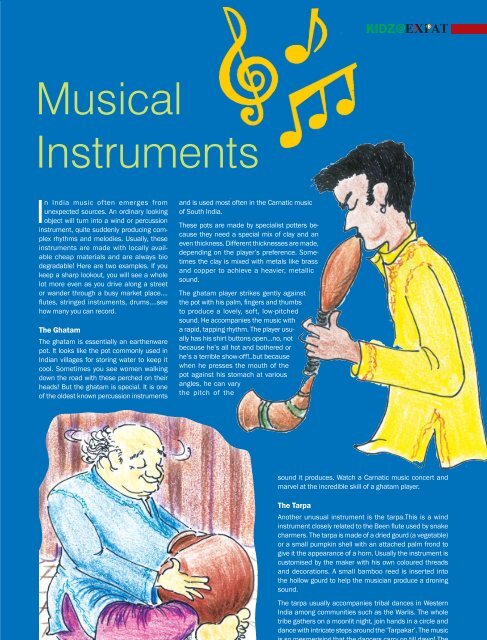to view Expat - LB Associates
to view Expat - LB Associates
to view Expat - LB Associates
You also want an ePaper? Increase the reach of your titles
YUMPU automatically turns print PDFs into web optimized ePapers that Google loves.
Musical<br />
Instruments<br />
In India music often emerges from<br />
unexpected sources. An ordinary looking<br />
object will turn in<strong>to</strong> a wind or percussion<br />
instrument, quite suddenly producing complex<br />
rhythms and melodies. Usually, these<br />
instruments are made with locally available<br />
cheap materials and are always bio<br />
degradable! Here are two examples. If you<br />
keep a sharp lookout, you will see a whole<br />
lot more even as you drive along a street<br />
or wander through a busy market place....<br />
fl utes, stringed instruments, drums....see<br />
how many you can record.<br />
The Ghatam<br />
The ghatam is essentially an earthenware<br />
pot. It looks like the pot commonly used in<br />
Indian villages for s<strong>to</strong>ring water <strong>to</strong> keep it<br />
cool. Sometimes you see women walking<br />
down the road with these perched on their<br />
heads! But the ghatam is special. It is one<br />
of the oldest known percussion instruments<br />
and is used most often in the Carnatic music<br />
of South India.<br />
These pots are made by specialist potters because<br />
they need a special mix of clay and an<br />
even thickness. Different thicknesses are made,<br />
depending on the player’s preference. Sometimes<br />
the clay is mixed with metals like brass<br />
and copper <strong>to</strong> achieve a heavier, metallic<br />
sound.<br />
The ghatam player strikes gently against<br />
the pot with his palm, fi ngers and thumbs<br />
<strong>to</strong> produce a lovely, soft, low-pitched<br />
sound. He accompanies the music with<br />
a rapid, tapping rhythm. The player usually<br />
has his shirt but<strong>to</strong>ns open...no, not<br />
because he’s all hot and bothered or<br />
he’s a terrible show-off!..but because<br />
when he presses the mouth of the<br />
pot against his s<strong>to</strong>mach at various<br />
angles, he can vary<br />
the pitch of the<br />
sound it produces. Watch a Carnatic music concert and<br />
marvel at the incredible skill of a ghatam player.<br />
The Tarpa<br />
Another unusual instrument is the tarpa.This is a wind<br />
instrument closely related <strong>to</strong> the Been fl ute used by snake<br />
charmers. The tarpa is made of a dried gourd (a vegetable)<br />
or a small pumpkin shell with an attached palm frond <strong>to</strong><br />
give it the appearance of a horn. Usually the instrument is<br />
cus<strong>to</strong>mised by the maker with his own coloured threads<br />
and decorations. A small bamboo reed is inserted in<strong>to</strong><br />
the hollow gourd <strong>to</strong> help the musician produce a droning<br />
sound.<br />
The tarpa usually accompanies tribal dances in Western<br />
India among communities such as the Warlis. The whole<br />
tribe gathers on a moonlit night, join hands in a circle and<br />
dance with intricate steps around the ‘Tarpakar’. The music






